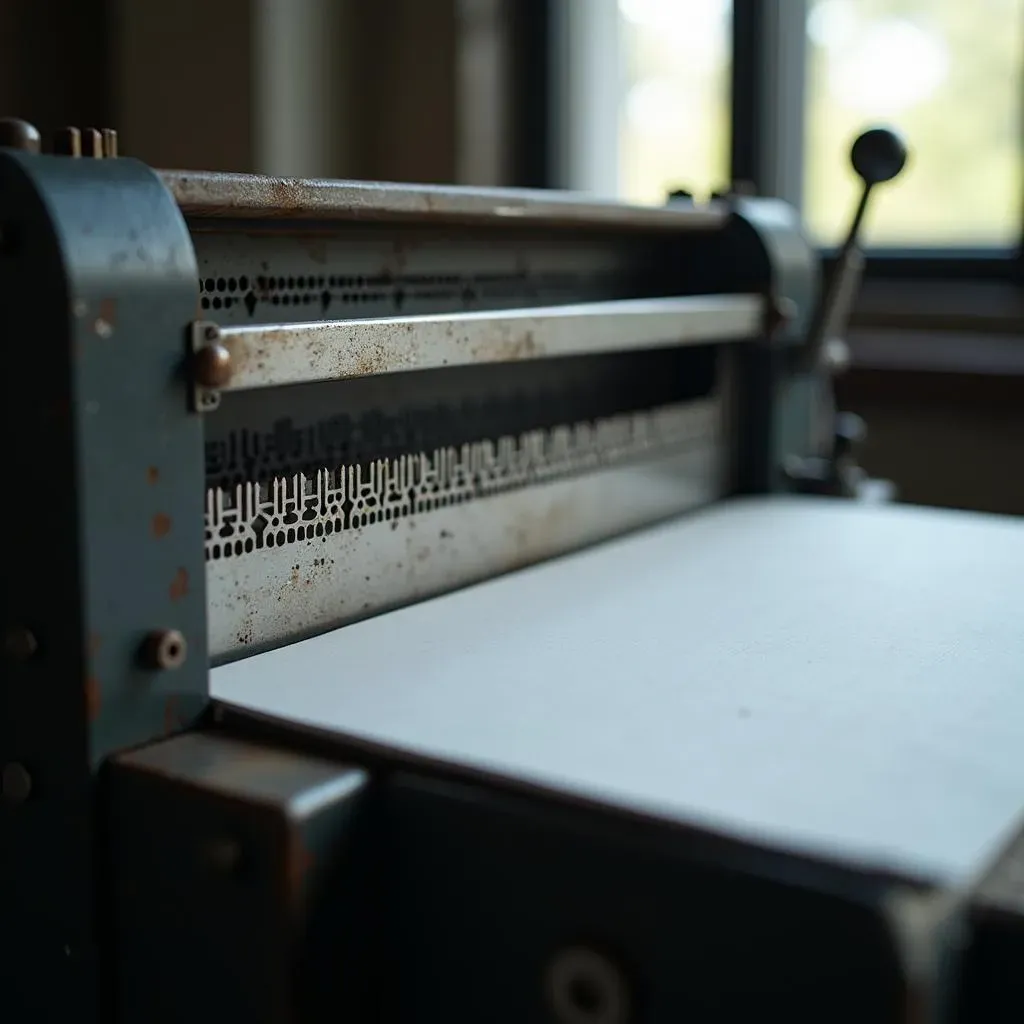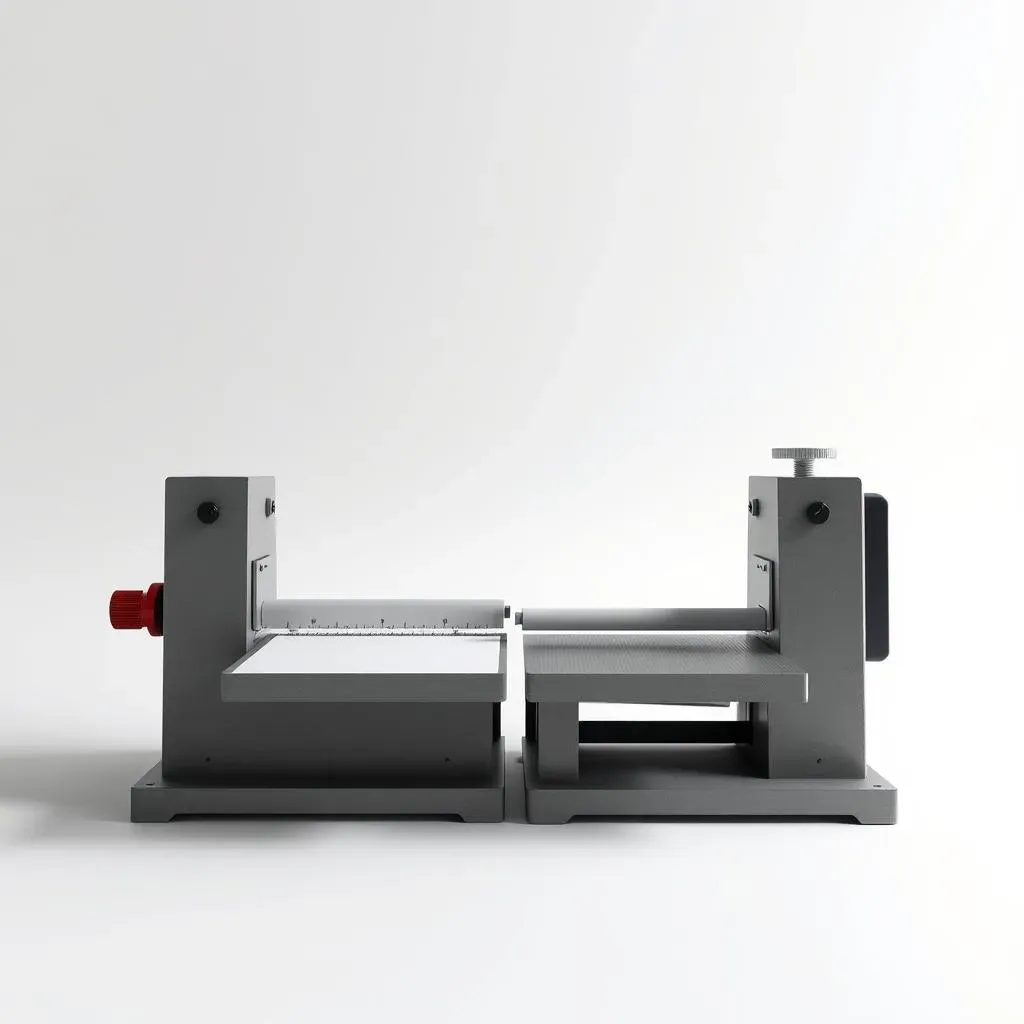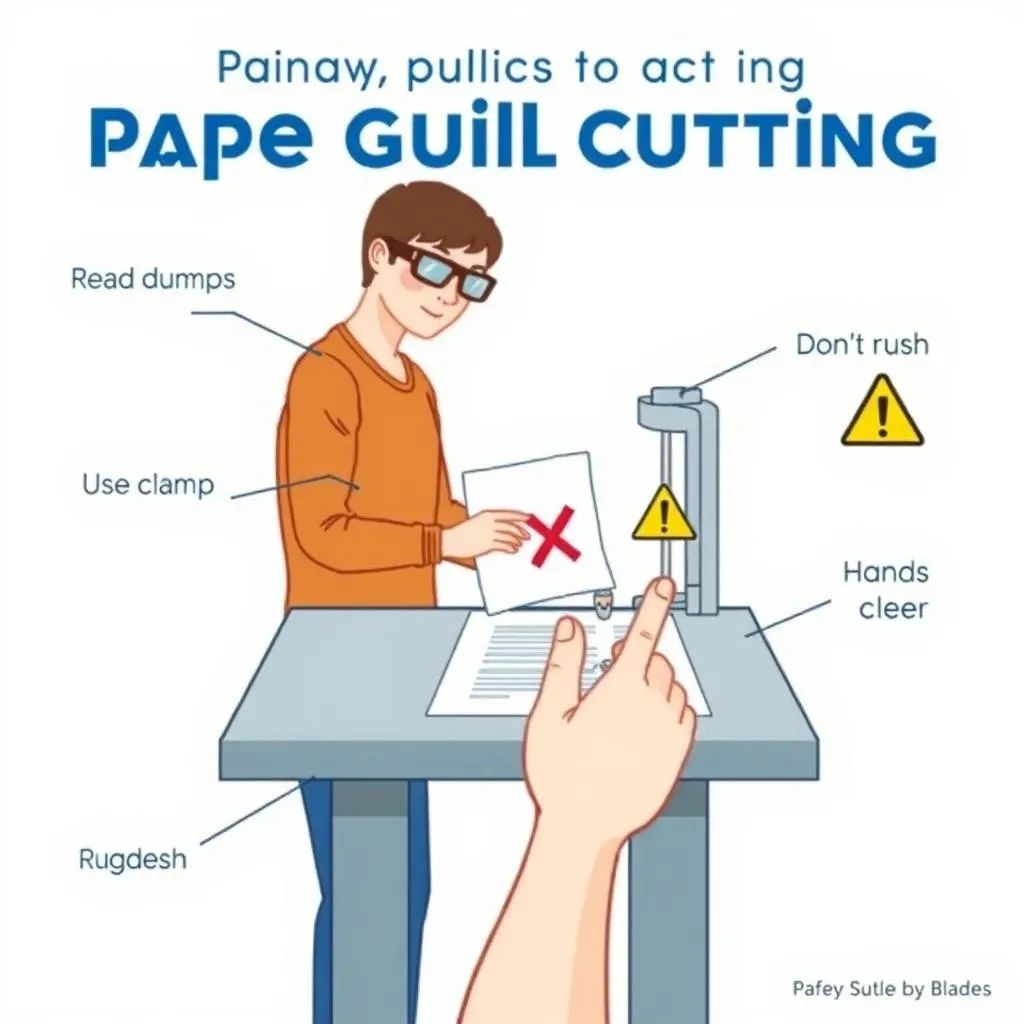Table of Contents
Ever stared at a stack of paper, dreaming of perfectly straight cuts? Me too. That's where the magic of a paper cutting guillotine machine comes in. Forget those flimsy, wobbly trimmers; we’re talking about serious cutting power here. This isn't just for print shops or big businesses. Whether you're a crafter, a teacher, or just someone who loves things neat, a good guillotine cutter is a game-changer. We're going to explore these mighty machines, from the simple manual models to the powerful electric ones. We'll talk about how to pick the right one for your needs, and most importantly, how to use it without losing any fingers. So, get ready to dive in, and let's make some cuts!
The Mighty Paper Cutting Guillotine Machine: What It Is
The Mighty Paper Cutting Guillotine Machine: What It Is
The Basics of a Guillotine Cutter
Okay, so you've probably seen one, maybe in a school or office, but what exactly is a paper cutting guillotine machine? It’s basically a big, sharp blade attached to a lever, designed to make clean, straight cuts through stacks of paper. Think of it like a super-sized, super-precise paper slicer. Unlike scissors or those rotary cutters, a guillotine uses a single, downward motion to cut through multiple sheets at once. This makes it way faster and more accurate for cutting larger quantities, especially if you are like me and hate uneven edges.
The name "guillotine" might sound a bit dramatic, but it perfectly describes how it works. The blade comes down with force, like a mini-guillotine, giving you that satisfying *thwack* sound when you cut. It's a simple design, but it's incredibly effective, and when you have a lot of paper to cut, you'll be glad it exists.
Feature | Description |
|---|---|
Blade | A long, sharp blade made of hardened steel. |
Lever | Used to bring the blade down with force. |
Base | A sturdy platform to hold the paper in place. |
Clamp | Often included to secure the paper stack. |
Why Use a Guillotine Cutter?
Why not just use scissors or a rotary cutter? Well, those are fine for small jobs, but a guillotine cutter is the champion when you need precision and speed. Imagine cutting a stack of 100 flyers for an event, all by hand with scissors—talk about a nightmare! A guillotine lets you do it in a fraction of the time, with each cut as straight as the last. This is crucial for things like brochures, invitations, or anything that needs a professional, finished look. I personally found this out the hard way when i tried to cut 50 flyers for my band with scissors, I learned that lesson real quick.
Another big plus is the clean edge it gives you. Scissors tend to tear or leave jagged edges, and rotary cutters can sometimes slip. A guillotine cutter, when used correctly, provides a crisp, clean cut every single time. This makes your finished products look way more polished and professional. It's the difference between a homemade look and something that looks like it came straight from a print shop.
A Brief History
Now, while the name might make you think of the French Revolution, paper guillotines have a much less dramatic history. They evolved from earlier cutting devices used in bookbinding and printing. The basic design—a blade and a lever—has remained remarkably consistent over the years, which says something about its effectiveness. The modern versions are often more refined and incorporate safety features, but the core principle is the same. It's a simple machine, but it's an example of great design that has stood the test of time.
Types of Paper Cutting Guillotine Machines: Manual vs. Electric
Types of Paper Cutting Guillotine Machines: Manual vs. Electric
Manual Guillotine Cutters: The Classics
Okay, let's start with the OGs, the manual paper cutting guillotine machines. These are the workhorses you often see in schools and smaller offices. They're powered by you, the user, using a lever to bring down the blade. No fancy motors, no plugs, just good old-fashioned mechanical cutting action. They’re usually less expensive than their electric counterparts, making them a great option if you're on a budget or just don't need to cut massive amounts of paper all the time. I remember using one in my school days, it was pretty fun, but I was always a bit nervous about the blade.
Manual guillotines are pretty straightforward. You place your paper, align it using the guides, and then bring the blade down firmly and smoothly. The quality of the cut really depends on how steady you are and how sharp the blade is. They're also usually smaller and lighter, so you can move them around more easily. I've seen some that are small enough to fit on a bookshelf, which is great if you’re tight on space. They’re perfect for smaller projects, card making, and the occasional stack of flyers.
Electric Guillotine Cutters: The Powerhouses
Now, let's talk about the big guns: electric paper cutting guillotine machines. These are the machines you'll find in professional print shops and larger businesses. They use an electric motor to power the blade, making cutting effortless and way faster. If you've got large volumes of paper to cut, an electric guillotine is the way to go, it will save you a lot of time and energy. I once had to help a friend cut 500 wedding invitations, we used an electric cutter, and it was a lifesaver.
Electric guillotines often come with advanced features like programmable cutting depths, safety sensors, and even digital displays. They can handle much thicker stacks of paper and offer more consistent, accurate cuts. These machines are an investment, but they pay off if you're doing a lot of cutting. Think of it like the difference between a bicycle and a motorcycle; both get you where you need to go, but one is way faster and more powerful.
Feature | Manual Guillotine | Electric Guillotine |
|---|---|---|
Power Source | Manual (lever) | Electric Motor |
Speed | Slower | Faster |
Cutting Capacity | Lower | Higher |
Price | Less Expensive | More Expensive |
Portability | More Portable | Less Portable |
Which Type is Right for You?
Choosing between a manual and an electric guillotine really comes down to your needs and budget. If you’re cutting small batches of paper, a manual cutter will do the job perfectly. They’re affordable, easy to use, and don’t require any power. On the other hand, if you’re dealing with large print runs or thicker materials, an electric guillotine is a worthy investment. It'll save you time, effort, and probably a few sore muscles. Think about how often you'll be using it, the types of projects you'll be working on, and of course, how much you're willing to spend. It's like choosing between a small car and a truck; both are good, but they're designed for different jobs. Ultimately, the best choice is the one that fits your specific needs.
Choosing the Right Paper Cutting Guillotine Machine for Your Needs
Choosing the Right Paper Cutting Guillotine Machine for Your Needs
Factors to Consider
Alright, so you're ready to get your own paper cutting guillotine machine, but where do you start? It’s not like picking out a new pen, there are a few things you need to think about. First up, how much paper are you planning to cut at a time? If you are just doing some crafts at home, a small manual one is probably fine. But if you’re running a business or doing large projects, you'll need something more robust. Think about the thickness of the paper too. Some guillotines are only good for thin paper, while others can handle cardstock or even thin plastic. It's like buying shoes; you wouldn't wear flip-flops to a marathon, would you?
Next, think about the size of the paper you'll be working with. If you're always cutting standard letter-size paper, then most guillotines will work. But if you need to cut larger formats, like A3 or poster sizes, you'll need a bigger machine with a longer blade. The size of the base is important too, it needs to be big enough to comfortably hold your paper without it hanging off the edges. And let's not forget the budget! Prices for guillotines can vary a lot, from budget-friendly manual options to high-end electric models. So, figure out what you need and what you’re willing to spend before diving in.
Factor | Description |
|---|---|
Cutting Capacity | How many sheets can it cut at once? |
Paper Size | What's the maximum paper size it can handle? |
Material Thickness | Can it cut thick cardstock or other materials? |
Budget | How much are you willing to spend? |
Features to Look For
Now that you have some idea of what you need, let's talk about features. A good clamp is essential. This holds the paper firmly in place while you cut, preventing it from moving and messing up your cut. Some guillotines have a manual clamp that you tighten by hand, while others have an automatic clamp that activates when you lower the blade. Another thing to look for is an alignment grid. This is a printed grid on the base of the guillotine, it helps you line up your paper perfectly before you cut, ensuring straight and precise cuts every time. It’s like having a ruler built right in to your machine, very handy.
Safety features are also super important, especially if you're working around kids or in a busy environment. Look for guillotines with blade guards, safety locks, or two-handed operation. These features help prevent accidental cuts and make the machine safer to use. Finally, check the quality of the blade. A sharp blade will give you cleaner cuts and last longer. Some guillotines have replaceable blades, while others require sharpening. It’s like buying a good kitchen knife; a sharp one makes all the difference.
Real-World Examples
Let's make this a bit more real. If you're a teacher, you might use a manual guillotine to cut out worksheets, crafts, or classroom decorations. A small, portable manual cutter would be ideal for this. If you're a small business owner, you might need a more robust electric guillotine to cut flyers, brochures, or marketing materials. In this case, you’d want something with a larger cutting capacity and a more precise blade. If you are a hobbyist, like me, you may want a smaller manual one for making cards or scrapbooking. Think about your specific needs, and pick a machine that makes your life easier. It’s all about finding the right tool for the job!
“The right tool for the job makes all the difference.” - Someone smart, probably
Safety First: How to Use a Paper Cutting Guillotine Machine Safely
Safety First: How to Use a Paper Cutting Guillotine Machine Safely
Understanding the Risks
Okay, let's be real, a paper cutting guillotine machine is not a toy. It's got a big, sharp blade that can cause serious injury if you're not careful. Think of it like a power tool, you wouldn't handle a saw carelessly, right? The most common accidents happen when people rush, don't pay attention, or don't use the machine properly. We're talking about cuts, lacerations, and other nasty injuries that you definitely want to avoid. I know, it sounds a bit scary, but with the right precautions, you can use a guillotine cutter safely. It's all about respect and awareness.
The biggest risk is, of course, the blade. It's designed to slice through paper, so it can slice through skin just as easily. Another danger is getting your fingers caught in the mechanism, especially if you're using a manual cutter. Electric guillotines have their own set of risks, like accidental activation. It's like driving a car; you need to be aware of the potential hazards and take steps to prevent them. So, let’s learn how to avoid all that unpleasantness, shall we?
Essential Safety Steps
First things first, always, always read the manufacturer's instructions before using a guillotine cutter. Every machine is a bit different, so you need to know the specific safety features and procedures for your model. Next, make sure you're working in a well-lit area. You need to see what you're doing, and avoid any shadows that could make you misalign your cut or put your fingers in danger. And, of course, never rush. Take your time, align your paper carefully, and make sure your hands are clear before you bring down the blade. It's not a race, it's about being precise and safe. I've learned this the hard way when I was in rush and made a nasty cut on my finger.
Another super important tip is to always use the clamp. This will hold the paper firmly in place and prevent it from shifting while you cut. If your guillotine has a blade guard or safety lock, use it! These are there for a reason, don't skip them. And, just a general rule, never put your fingers under the blade while you're cutting. It's a basic rule, but it's one that’s easy to forget. If you’re not sure about something, it’s better to ask or look it up than to risk an injury. Safety is not just about following rules; it’s about being smart and responsible.
Safety Step | Description |
|---|---|
Read Instructions | Always read the manufacturer's manual. |
Work Area | Ensure a well-lit workspace. |
Take Your Time | Don't rush, be precise. |
Use the Clamp | Secure the paper with the clamp. |
Safety Features | Use blade guards and safety locks. |